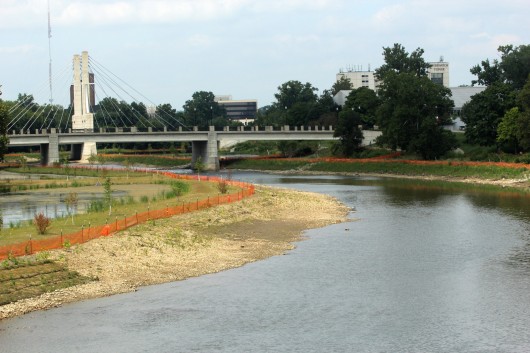
Geese removal efforts wind down along the Olentangy River where noisemakers and pyrotechnics have been used to scare away the birds.
Credit: Mark Batke / Photo Editor
The Ohio State community can expect to hear and see less pyrotechnics and noisemakers in the Olentangy River area as efforts to drive away geese decrease.
“Basically, we’ll be out there once a week monitoring the sites. Right now, pyrotechnics and noise efforts have been decreased,” said Jeff Pelc, a wildlife biologist with the U.S. Department of Agriculture Wildlife Services.
Previously, the geese were driven away using techniques such as lasers and mylar tape.
It’s all in an effort to drive the geese away so vegetation near the river can grow, said George Zonders, spokesman for the Columbus Department of Public Utilities.
“We are establishing native grasses which require seed. Geese are naturally attracted to this,” Zonders said. “We are not in the business of establishing free buffets for geese.”
The geese removal efforts, which started in March, are part of the $6.9 million Olentangy River renovation.
The project began in August 2012 with the partial removal of the Fifth Avenue Dam. About one-third of the structure was removed completely, while along the remaining length of the dam, the top two feet of concrete were removed and the rest was covered with soil.
The project has since been completed on schedule and within budget, Zonders said.
Overall, the restoration aims to mimic nature, Zonders said.
“The goal was basically to remove a dam that was no longer really necessary,” Zonders said. “(The project) increases biological diversity that was removed, I would say studded, while the dam was there,” Zonders said.
OSU plans to use the renovated river area for teaching and research, according to an OSU website.
Even though the use of noisemakers and pyrotechnics has decreased since removal efforts started, Zonders said the river area still needs to be guarded from another threat.
“While growth of the native plants and grasses through most of the project corridor is looking good, we feel the area would benefit through extended protection from people walking through the new riverbank areas,” Zonders said.
Friends of the Lower Olentangy Watershed, a volunteer organization dedicated to the cleanliness and safety of the Olentangy River, suggested other techniques for the removal of the geese.
“FLOW proposed the Ohio Wildlife Center program called SCRAM, which has trained dogs to disturb goose activity. The restoration team thought that this would require multiple dogs (and handlers) to be effective,” Laura Fay, science committee chair for FLOW, said in an email.
But Pelc said the techniques used by the USDA worked in guarding the exposed soil.
“They are not harmful to the geese, just very disruptive to them,” he said. “Eventually the geese will be welcomed back, but for now, it is very critical that the vegetation is established. The seed is very vulnerable.”
Correction: Aug. 27, 2014
An earlier version of this story misspelled the name of George Zonders, a spokesman for the Columbus Department of Public Utilities.


